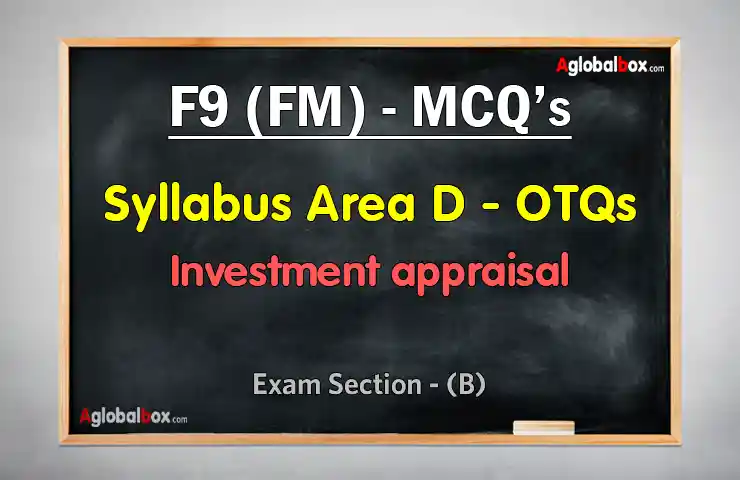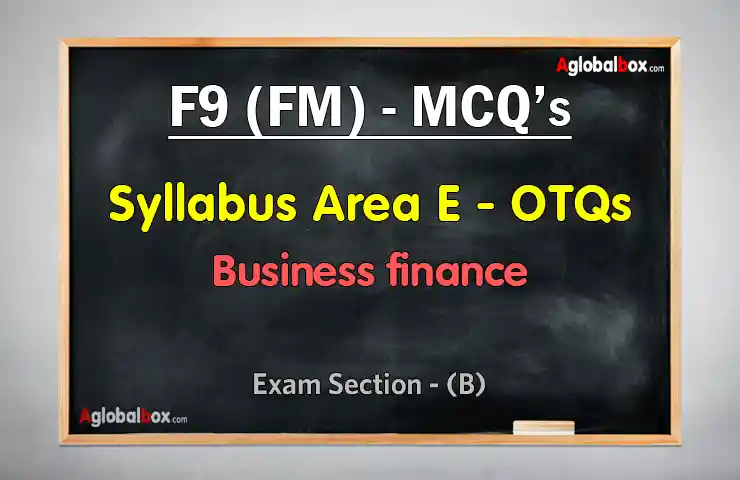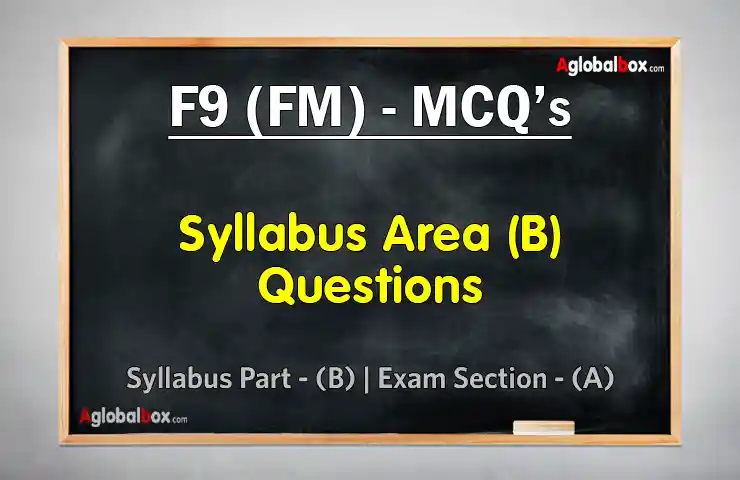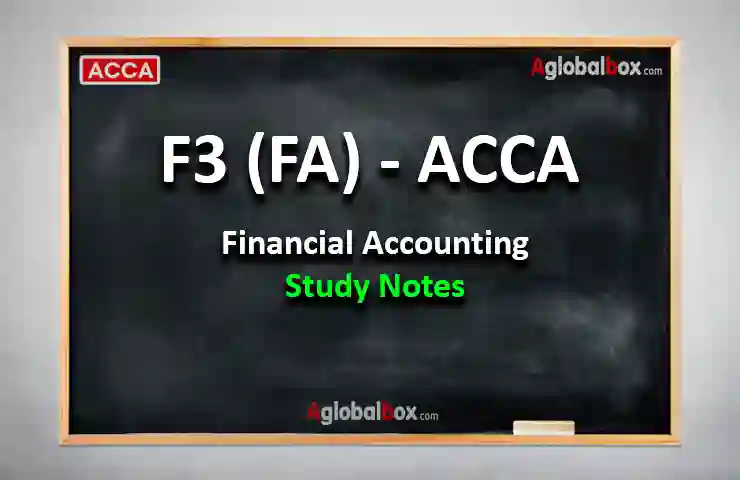These are ACCA F9 (FM) Financial Management Part-D of the Syllabus “Investment appraisal” .
These multiple-choice questions (MCQs) are designed to help ACCA F9 students to better understand the exam format. We aim to instill in students the habit of practicing online for their CBE exams . By doing so, students can reduce exam stress and prepare more effectively.
Please note:
Students should not attempt these MCQs until they have finished the entire chapter.
All questions are compulsory, so please do not skip any.
We hope that these MCQs will be a valuable resource for students preparing for the ACCA F9 (FM) exam .
Course: ACCD – Association of Chartered Certified Accountants Fundamental Level: Applied Skills Subject: Financial Management Paper: F9 – FR Chapter and Topic Investment appraisal techniques, Allowing for inflation and taxation in DCF, Adjusting for risk and uncertainty in investment appraisal, Specific investment decisions (lease or buy, asset replacement, capital rationing) Questions: Sensitivity analysis Guilder Co Trecor Co BRT Co Syllabus Area: D – “Investment appraisal” Questions Type: CBE MCQs Exam Section: Section A
Syllabus Area
These Multiple Choice Questions (MCQs) cover the Syllabus Area Part D of the Syllabus; “Investment appraisal” of ACCA F9 (FM) Financial Management Module.
Time
These MCQs are not time-bound. Take your time and solve them without stress. Pay proper attention and focus. Do not rush or hesitate
Result
Students will get their F9 CBE MCQs Test results after they finish the entire test. They will also be able to see the correct and incorrect answers, as well as explanations for the incorrect questions.
Types of Questions
MCQs: Choose one from the given options. Multiple choice: Choose all those answers which seem correct/ or incorrect to you, as per the requirement of the question. Keep your eye on the wording “(select all those which are correct/ or incorrect) “. Drop-down: Select from the list provided. Type numbers: Type your answer in numbers as per the requirement of the question.
QUESTION – Sensitivity analysis – (01/04)
QUESTION – Guilder Co – (02/04)
F9 (FM) - Part D - MCQs - Guilder Co
Course: ACCA - Association of Chartered Certified AccountantsSyllabus Area: D - Investment appraisalChapter: 07 Investment decisions, 08 Investment appraisal using DCF methods, 09 Allowing for inflation and taxation, 10 Project appraisal and risk, 11 Specific investment decisionsExam Section: Section BQuestion Name: Guilder CoQuestions type: MCQsTime: No Time Limit
INSTRUCTIONS
If you are using mobile, turn on the mobile rotation and solve the MCQs on wide screen for better experience.
REQUEST
Please rate the quiz and give us feedback once you completed the quiz.
Share with ACCA students on social media such as, Facebook Groups, Whatsapp, Telegram, etc.
1 / 5
The following scenario relates to questions 1–5.
CASE SCENARIO
Guilder Co is appraising four different projects but is experiencing capital rationing in Year 0. No capital rationing is expected in future periods but none of the four projects that Guilder Co is considering can be postponed, so a decision must be made now. Guilder Co's cost of capital is 12%.
The following information is available.
Outlay in
Project
Year 0
PV
NPV
$
$
$
Amster
100,000
111,400
11,400
Eind
56,000
62,580
6,580
Utrec
60,000
68,760
8,760
Tilbur
90,000
102,400
12,400
REQUIREMENT
The following potential cash flows are predicted for maintenance costs for the Great machine:
Year Cash flow Probability
$
2
19,000
0.55
2
26,000
0.45
3
21,000
0.30
2
25,000
0.25
3
31,000
0.45
What is the expected present value of the maintenance costs for Year 2? (to the nearest whole number $)
2 / 5
The following scenario relates to questions 1–5.
CASE SCENARIO
Guilder Co is appraising four different projects but is experiencing capital rationing in Year 0. No capital rationing is expected in future periods but none of the four projects that Guilder Co is considering can be postponed, so a decision must be made now. Guilder Co's cost of capital is 12%.
The following information is available.
Outlay in
Project
Year 0
PV
NPV
$
$
$
Amster
100,000
111,400
11,400
Eind
56,000
62,580
6,580
Utrec
60,000
68,760
8,760
Tilbur
90,000
102,400
12,400
REQUIREMENT
Which of the following statements concerning Guilder Co's use of the EAC are TRUE ?
The use of equivalent annual cost is appropriate in periods of high inflation.
The EAC method assumes that the machine can be replaced by exactly the same machine in perpetuity.
3 / 5
The following scenario relates to questions 1–5.
CASE SCENARIO
Guilder Co is appraising four different projects but is experiencing capital rationing in Year 0. No capital rationing is expected in future periods but none of the four projects that Guilder Co is considering can be postponed, so a decision must be made now. Guilder Co's cost of capital is 12%.
The following information is available.
Outlay in
Project
Year 0
PV
NPV
$
$
$
Amster
100,000
111,400
11,400
Eind
56,000
62,580
6,580
Utrec
60,000
68,760
8,760
Tilbur
90,000
102,400
12,400
REQUIREMENT
Several years later, there is no capital rationing and Guilder Co decides to replace an existing machine. Guilder Co has the choice of either a Super machine (lasting four years) or a Great machine (lasting three years).
The following present value table includes the figures for a Super machine.
0
1
2
3
4
Maintenance costs
(20,000)
(29,000)
(32,000)
(35,000)
Investment and scrap
(250,000)
25,000
Net cash flow
(250,000)
(20,000)
(29,000)
(32,000)
(10,000)
Discount at 12%
1.000
0.893
0.797
0.712
0.636
Present values
(250,000)
(17,860)
(23,113)
(22,784)
(6,360)
Tax and tax-allowable depreciation should be ignored.
What is the equivalent annual cost (EAC) of the Super machine? (to the nearest whole number $)
4 / 5
The following scenario relates to questions 1–5.
CASE SCENARIO
Guilder Co is appraising four different projects but is experiencing capital rationing in Year 0. No capital rationing is expected in future periods but none of the four projects that Guilder Co is considering can be postponed, so a decision must be made now. Guilder Co's cost of capital is 12%.
The following information is available.
Outlay in
Project
Year 0
PV
NPV
$
$
$
Amster
100,000
111,400
11,400
Eind
56,000
62,580
6,580
Utrec
60,000
68,760
8,760
Tilbur
90,000
102,400
12,400
REQUIREMENT
Which of the following statements about Guilder Co's decision to use PI is TRUE ?
5 / 5
The following scenario relates to questions 1–5.
CASE SCENARIO
Guilder Co is appraising four different projects but is experiencing capital rationing in Year 0. No capital rationing is expected in future periods but none of the four projects that Guilder Co is considering can be postponed, so a decision must be made now. Guilder Co's cost of capital is 12%.
The following information is available.
Outlay in
Project
Year 0
PV
NPV
$
$
$
Amster
100,000
111,400
11,400
Eind
56,000
62,580
6,580
Utrec
60,000
68,760
8,760
Tilbur
90,000
102,400
12,400
REQUIREMENT
What is the correct order of the projects based on their preference to Guilder using the profitability index? The most attractive will come first.
Amster: 1, Eind: 2, Utrec: 3, Tilbur: 4
Amster: 2, Eind: 4, Utrec: 1, Tilbur: 3
Amster: 4, Eind: 3, Utrec: 1, Tilbur: 2
Amster: 3, Eind: 1, Utrec: 4, Tilbur: 2
QUESTION – Trecor Co – (03/04)
F9 (FM) - Part D - MCQs - Trecor Co
Course: ACCA - Association of Chartered Certified AccountantsSyllabus Area: D - Investment appraisalChapter: 07 Investment decisions, 08 Investment appraisal using DCF methods, 09 Allowing for inflation and taxation, 10 Project appraisal and risk, 11 Specific investment decisionsExam Section: Section BQuestion Name: Trecor CoQuestions type: MCQsTime: No Time Limit
INSTRUCTIONS
If you are using mobile, turn on the mobile rotation and solve the MCQs on wide screen for better experience.
REQUEST
Please rate the quiz and give us feedback once you completed the quiz.
Share with ACCA students on social media such as, Facebook Groups, Whatsapp, Telegram, etc.
1 / 5
The following scenario relates to questions 1–5.
CASE SCENARIO
Trecor Co plans to buy a machine costing $250,000 which will last for 4 years and then be sold for $5,000.
Net cash flows before tax are expected to be as follows.
T₁ T₂ T₃ T₄
Net cash flow $
122,000
143,000
187,000
78,000
Depreciation is charged on a straight-line basis over the life of an asset.
REQUIREMENT
Which TWO of the following statements about the internal rate of return (IRR) are TRUE ?
2 / 5
The following scenario relates to questions 1–5.
CASE SCENARIO
Trecor Co plans to buy a machine costing $250,000 which will last for 4 years and then be sold for $5,000.
Net cash flows before tax are expected to be as follows.
T₁ T₂ T₃ T₄
Net cash flow $
122,000
143,000
187,000
78,000
Depreciation is charged on a straight-line basis over the life of an asset.
REQUIREMENT
What is the payback period for the machine? (to the nearest whole month)
3 / 5
The following scenario relates to questions 1–5.
CASE SCENARIO
Trecor Co plans to buy a machine costing $250,000 which will last for 4 years and then be sold for $5,000.
Net cash flows before tax are expected to be as follows.
T₁ T₂ T₃ T₄
Net cash flow $
122,000
143,000
187,000
78,000
Depreciation is charged on a straight-line basis over the life of an asset.
REQUIREMENT
Trecor Co can claim tax-allowable depreciation on a 25% reducing balance It pays tax at an annual rate of 30% one year in arrears.
What amount of tax relief would be received by Trecor in time 4 of a net present value (NPV) calculation?
$_______
4 / 5
The following scenario relates to questions 1–5.
CASE SCENARIO
Trecor Co plans to buy a machine costing $250,000 which will last for 4 years and then be sold for $5,000.
Net cash flows before tax are expected to be as follows.
T₁ T₂ T₃ T₄
Net cash flow $
122,000
143,000
187,000
78,000
Depreciation is charged on a straight-line basis over the life of an asset.
REQUIREMENT
Which of the following statement on return on capital employed (ROCE) is False ?
5 / 5
The following scenario relates to questions 1–5.
CASE SCENARIO
Trecor Co plans to buy a machine costing $250,000 which will last for 4 years and then be sold for $5,000.
Net cash flows before tax are expected to be as follows.
T₁ T₂ T₃ T₄
Net cash flow $
122,000
143,000
187,000
78,000
Depreciation is charged on a straight-line basis over the life of an asset.
REQUIREMENT
Calculate the before-tax return on capital employed (accounting rate of return) based on the average investment. (to the nearest whole percentage)
______%
QUESTION – BRT Co – (04/04)
F9 (FM) - Part D - MCQs - BRT Co
Course: ACCA - Association of Chartered Certified AccountantsSyllabus Area: D - Investment appraisalChapter: 07 Investment decisions, 08 Investment appraisal using DCF methods, 09 Allowing for inflation and taxation, 10 Project appraisal and risk, 11 Specific investment decisionsExam Section: Section BQuestion Name: BRT CoQuestions type: MCQsTime: No Time Limit
INSTRUCTIONS
If you are using mobile, turn on the mobile rotation and solve the MCQs on wide screen for better experience.
REQUEST
Please rate the quiz and give us feedback once you completed the quiz.
Share with ACCA students on social media such as, Facebook Groups, Whatsapp, Telegram, etc.
1 / 5
The following scenario relates to questions 1–5.
CASE SCENARIO
BRT Co has developed a new confectionery line that can be sold for $5.00 per box and that is expected to have continuing popularity for many years. The finance director has proposed that investment in the new product should be evaluated over a four-year time-horizon, even though sales would continue after the fourth year, on the grounds that cash flows after four years are too uncertain to be included.
The variable cost (in current price terms) will depend on sales volume, as follows.
Sales volume (boxes)
Less than 1 million
1–1.9 million
2–2.9 million
3–3.9 million
Variable cost ($ per box)
2.80
3.00
3.00
3.05
Forecast sales volumes are as follows.
Year
1 2 3 4
Demand (boxes)
0.7 million
1.6 million
2.1 million
3.0 million
Tax
Tax-allowable depreciation on a 25% reducing balance basis could be claimed on the cost of equipment. Profit tax of 30% per year will be payable one year in arrears. A balancing allowance would be claimed in the fourth year of operation.
Inflation
The average general level of inflation is expected to be 3% per year for the selling price and variable costs. BRT Co uses a nominal after-tax cost of capital of 12% to appraise new investment projects.
A trainee accountant at BRT Co has started a spreadsheet to calculate the net present value (NPV) of a proposed new project.
A B C D E F G
1
Year
0
1
2
3
4
5
2
$'000
$'000
$'000
$'000
$'000
$'000
3
Inflated sales
4
Inflated variable costs
5
Fixed costs
(1,030)
(1,910)
(3,060)
(4,277)
6
Net cash flow
556
1,485
1,530
2,308
7
Taxation
8
Tax benefits
9
Working capital
(750)
(23)
(23)
(24)
750
10
Investment
(2,000)
11
Project cash flows
12
Discount factor 12%
1.000
0.893
0.797
0.712
0.636
0.567
13
Present value
REQUIREMENT
The trainee accountant at BRT Co has calculated the internal rate of return (IRR) for the project.
Are the following statements true or false?
When cash flow patterns are conventional, the NPV and IRR methods will give the same accept or reject decision.
The project is financially viable under IRR if it exceeds the cost of capital.
2 / 5
The following scenario relates to questions 1–5.
CASE SCENARIO
BRT Co has developed a new confectionery line that can be sold for $5.00 per box and that is expected to have continuing popularity for many years. The finance director has proposed that investment in the new product should be evaluated over a four-year time-horizon, even though sales would continue after the fourth year, on the grounds that cash flows after four years are too uncertain to be included.
The variable cost (in current price terms) will depend on sales volume, as follows.
Sales volume (boxes)
Less than 1 million
1–1.9 million
2–2.9 million
3–3.9 million
Variable cost ($ per box)
2.80
3.00
3.00
3.05
Forecast sales volumes are as follows.
Year
1 2 3 4
Demand (boxes)
0.7 million
1.6 million
2.1 million
3.0 million
Tax
Tax-allowable depreciation on a 25% reducing balance basis could be claimed on the cost of equipment. Profit tax of 30% per year will be payable one year in arrears. A balancing allowance would be claimed in the fourth year of operation.
Inflation
The average general level of inflation is expected to be 3% per year for the selling price and variable costs. BRT Co uses a nominal after-tax cost of capital of 12% to appraise new investment projects.
A trainee accountant at BRT Co has started a spreadsheet to calculate the net present value (NPV) of a proposed new project.
A B C D E F G
1
Year
0
1
2
3
4
5
2
$'000
$'000
$'000
$'000
$'000
$'000
3
Inflated sales
4
Inflated variable costs
5
Fixed costs
(1,030)
(1,910)
(3,060)
(4,277)
6
Net cash flow
556
1,485
1,530
2,308
7
Taxation
8
Tax benefits
9
Working capital
(750)
(23)
(23)
(24)
750
10
Investment
(2,000)
11
Project cash flows
12
Discount factor 12%
1.000
0.893
0.797
0.712
0.636
0.567
13
Present value
REQUIREMENT
Which of the following statements about the project appraisal is False ?
3 / 5
The following scenario relates to questions 1–5.
CASE SCENARIO
BRT Co has developed a new confectionery line that can be sold for $5.00 per box and that is expected to have continuing popularity for many years. The finance director has proposed that investment in the new product should be evaluated over a four-year time-horizon, even though sales would continue after the fourth year, on the grounds that cash flows after four years are too uncertain to be included.
The variable cost (in current price terms) will depend on sales volume, as follows.
Sales volume (boxes)
Less than 1 million
1–1.9 million
2–2.9 million
3–3.9 million
Variable cost ($ per box)
2.80
3.00
3.00
3.05
Forecast sales volumes are as follows.
Year
1 2 3 4
Demand (boxes)
0.7 million
1.6 million
2.1 million
3.0 million
Tax
Tax-allowable depreciation on a 25% reducing balance basis could be claimed on the cost of equipment. Profit tax of 30% per year will be payable one year in arrears. A balancing allowance would be claimed in the fourth year of operation.
Inflation
The average general level of inflation is expected to be 3% per year for the selling price and variable costs. BRT Co uses a nominal after-tax cost of capital of 12% to appraise new investment projects.
A trainee accountant at BRT Co has started a spreadsheet to calculate the net present value (NPV) of a proposed new project.
A B C D E F G
1
Year
0
1
2
3
4
5
2
$'000
$'000
$'000
$'000
$'000
$'000
3
Inflated sales
4
Inflated variable costs
5
Fixed costs
(1,030)
(1,910)
(3,060)
(4,277)
6
Net cash flow
556
1,485
1,530
2,308
7
Taxation
8
Tax benefits
9
Working capital
(750)
(23)
(23)
(24)
750
10
Investment
(2,000)
11
Project cash flows
12
Discount factor 12%
1.000
0.893
0.797
0.712
0.636
0.567
13
Present value
REQUIREMENT
What are the tax benefits generated by the tax-allowable depreciation on the equipment in Year 4 (cell F8) , to the nearest $'000
4 / 5
The following scenario relates to questions 1–5.
CASE SCENARIO
BRT Co has developed a new confectionery line that can be sold for $5.00 per box and that is expected to have continuing popularity for many years. The finance director has proposed that investment in the new product should be evaluated over a four-year time-horizon, even though sales would continue after the fourth year, on the grounds that cash flows after four years are too uncertain to be included.
The variable cost (in current price terms) will depend on sales volume, as follows.
Sales volume (boxes)
Less than 1 million
1–1.9 million
2–2.9 million
3–3.9 million
Variable cost ($ per box)
2.80
3.00
3.00
3.05
Forecast sales volumes are as follows.
Year
1 2 3 4
Demand (boxes)
0.7 million
1.6 million
2.1 million
3.0 million
Tax
Tax-allowable depreciation on a 25% reducing balance basis could be claimed on the cost of equipment. Profit tax of 30% per year will be payable one year in arrears. A balancing allowance would be claimed in the fourth year of operation.
Inflation
The average general level of inflation is expected to be 3% per year for the selling price and variable costs. BRT Co uses a nominal after-tax cost of capital of 12% to appraise new investment projects.
A trainee accountant at BRT Co has started a spreadsheet to calculate the net present value (NPV) of a proposed new project.
A B C D E F G
1
Year
0
1
2
3
4
5
2
$'000
$'000
$'000
$'000
$'000
$'000
3
Inflated sales
4
Inflated variable costs
5
Fixed costs
(1,030)
(1,910)
(3,060)
(4,277)
6
Net cash flow
556
1,485
1,530
2,308
7
Taxation
8
Tax benefits
9
Working capital
(750)
(23)
(23)
(24)
750
10
Investment
(2,000)
11
Project cash flows
12
Discount factor 12%
1.000
0.893
0.797
0.712
0.636
0.567
13
Present value
REQUIREMENT
What are the variable costs for Year 3 (cell E4 in the spreadsheet) , to the nearest $'000?
5 / 5
The following scenario relates to questions 1–5.
CASE SCENARIO
BRT Co has developed a new confectionery line that can be sold for $5.00 per box and that is expected to have continuing popularity for many years. The finance director has proposed that investment in the new product should be evaluated over a four-year time-horizon, even though sales would continue after the fourth year, on the grounds that cash flows after four years are too uncertain to be included.
The variable cost (in current price terms) will depend on sales volume, as follows.
Sales volume (boxes)
Less than 1 million
1–1.9 million
2–2.9 million
3–3.9 million
Variable cost ($ per box)
2.80
3.00
3.00
3.05
Forecast sales volumes are as follows.
Year
1 2 3 4
Demand (boxes)
0.7 million
1.6 million
2.1 million
3.0 million
Tax
Tax-allowable depreciation on a 25% reducing balance basis could be claimed on the cost of equipment. Profit tax of 30% per year will be payable one year in arrears. A balancing allowance would be claimed in the fourth year of operation.
Inflation
The average general level of inflation is expected to be 3% per year for the selling price and variable costs. BRT Co uses a nominal after-tax cost of capital of 12% to appraise new investment projects.
A trainee accountant at BRT Co has started a spreadsheet to calculate the net present value (NPV) of a proposed new project.
A B C D E F G
1
Year
0
1
2
3
4
5
2
$'000
$'000
$'000
$'000
$'000
$'000
3
Inflated sales
4
Inflated variable costs
5
Fixed costs
(1,030)
(1,910)
(3,060)
(4,277)
6
Net cash flow
556
1,485
1,530
2,308
7
Taxation
8
Tax benefits
9
Working capital
(750)
(23)
(23)
(24)
750
10
Investment
(2,000)
11
Project cash flows
12
Discount factor 12%
1.000
0.893
0.797
0.712
0.636
0.567
13
Present value
REQUIREMENT
What is the sales figure for Year 2 (cell D3 in the spreadsheet) , to the nearest $'000?













